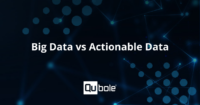Big data is transforming entire industries, and the media industry is no exception. Once media companies relied on traditional data to make educated guesses at what content consumers were looking for. Today they have mountains of rich data that reveal what consumers are doing, searching, consuming, tweeting, liking, and sharing. Armed with this information, media companies gain valuable insights into consumer behaviors—insights they can use to deliver more relevant content and provide better customer experiences.
What Big data strategies are media companies using to improve the consumer experience?
Building personalized connections: Big data analytics gives media companies a granular digital view of their customers. Knowing what a customer likes, and dislikes, what they are interested in, what social media platforms they prefer, and what they are most likely to consume and buy allows these companies to build personalized connections that enhance the customer’s experience.
Delivering highly targeted promotions: Consumers like to feel that the companies they deal with know and genuinely care about their wants, needs, and preferences. And promotions that come across as generic and “spammy” only succeed in diminishing the customer experience. By using data analytics to gain a clear and precise understanding of a customer’s individual preferences, media companies can carry out highly targeted and personalized promotions featuring relevant content and offer that customers want to know about.
Acquiring the right content: With so much content out there, publishing and entertainment companies are constantly faced with the challenge of acquiring content that will be the most popular with the various segments of customers that they serve. By providing a better understanding of customer needs and wants, big data helps media companies select the content that will give their customers the most enjoyable experience.
Providing real-time recommendations: Today’s tech-savvy consumers judge their experiences, not only on the quality of the product or service but on how quickly it’s provided. Just as streaming technologies allow consumers to experience content pretty much instantly, big data analytics tools allow media companies to make content recommendations in real-time, thus allowing the user to select and experience the content they want easily and quickly.
Big Data in Media Use Cases
A few examples of media companies that have successfully leveraged big data to enhance the consumer experience are:
Spotify
Spotify, the popular music streaming service, uses a Hadoop big data analytics platform to gather massive amounts of data from over 60 million active users worldwide. Spotify then uses that analyzed data from user profiles, playlists, and other historical data to make informed, personal, and relevant recommendations to individual users of other music they might enjoy listening to.
Spotify also uses big data and predictive analytics to add fun to the consumer experience. One case in point is the Grammy Awards, where Spotify uses streaming data to predict award winners each year. Based on the results from the 2013, 2014, and 2015 Grammy Awards, Spotify’s predictions came true a large percentage of the time.
Amazon Prime
Offering “exclusive access to music, movies, TV shows, and Kindle books,” Amazon Prime is all about providing a great customer experience. Utilizing the same advanced analytics tools that made Amazon.com the one-stop-shopping behemoth that it is today, Amazon “Prime Music” and “Prime Instant Video” streaming services leverage big data to give consumers a myriad of personalized entertainment choices on a multitude of devices, instantly, anywhere and at any time —no drones needed.
Netflix
When it comes to media companies that have successfully leveraged big data to drive revenues and optimize the consumer experience, Netflix is the proverbial poster child. As a leading provider of on-demand Internet streaming media with over 40 million users, Netflix gathers massive volumes of consumer behavior data each and every day. By knowing what content its viewers are searching for, along with how they are consuming and rating that content—not to mention when and where they are watching and on what devices—Netflix can better select available content for its viewers. It can also use big data insights to create unique original content, such as the hit series “House of Cards”. Leveraging big data gives Netflix a major competitive advantage, as the company gives customers, not just what they want, but when and how they want it, which is what an optimal consumer experience is all about.
A Big Data strategy is necessary to stay competitive in the media industry. In fact, many media companies that are flourishing today would not even exist if it weren’t for big data analytics technologies. As customer expectations continue to rise, those companies committed to using big data analytics tools to up the consumer experience will continue to thrive while those that do won’t survive.
Interested in learning more about big data applications in the media and entertainment industry? Check out our media industry solutions page.




